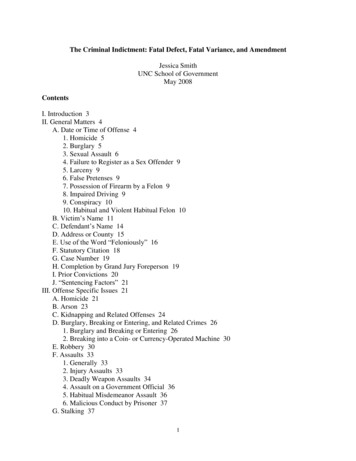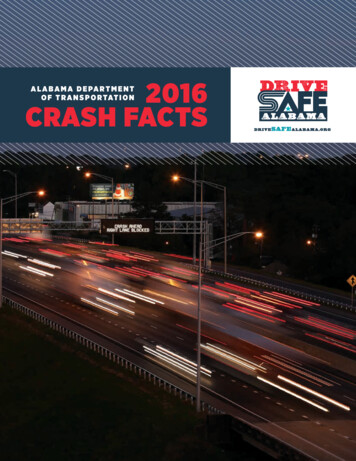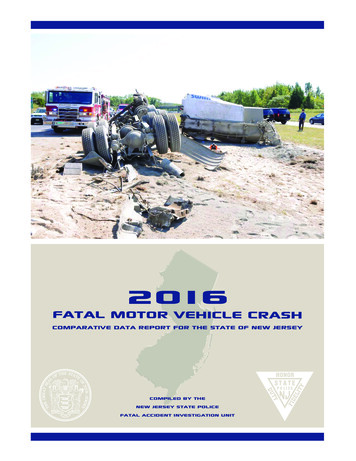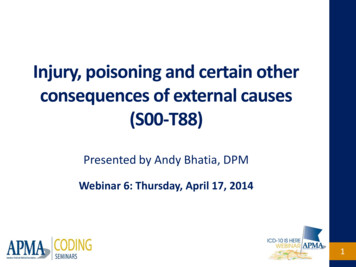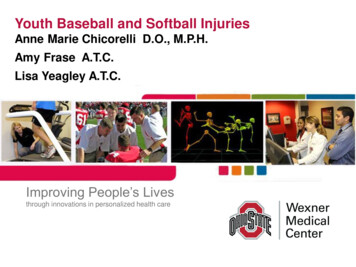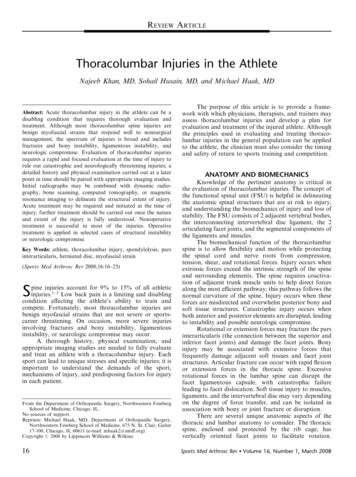
Transcription
For Release: Thursday, June 04, 2020MID-ATLANTIC INFORMATION OFFICE: Philadelphia, Pa.Technical information: (215) 597-3282 BLSInfoPhiladelphia@bls.govMedia contact:(215) 861-5600 /regions/mid-atlanticFatal Work Injuries in the Washington, DC Area — 2018Fatal work injuries totaled 68 in 2018 for the Washington-Arlington-Alexandria, DC-VA-MD-WVMetropolitan Statistical Area, the U.S. Bureau of Labor Statistics reported today. Sheila Watkins, the Bureau’sregional commissioner, noted that the number of work-related fatalities in the Washington metropolitan areaincreased by five from the previous year. Fatal occupational injuries in the metropolitan area have ranged froma high of 99 in 2005 to a low of 43 in 2015. (See chart 1.)Nationwide, a total of 5,250 fatal work injuries were recorded in 2018, up from the 5,147 fatal injuries in2017, according to the results from the Census of Fatal Occupational Injuries (CFOI) program.
In 2018, the Washington metropolitan area had the sixth-largest population nationally[1] and had the thirdlowest number of work-related fatalities among the 10 largest metropolitan statistical areas in the UnitedStates. (See table 1 and chart 2.) The most populated metropolitan area in the country—New York—had thehighest number of workplace fatalities (209) in 2018. The smallest of the 10 metropolitan areas—Boston—hadthe lowest fatality count with 60 deaths.Type of incidentIn the Washington metropolitan area, transportation incidents was the most frequent fatal event, resulting in 18fatal work injuries during 2018, an increase of 2 from the previous year. (See table 1 and table 2.) The share oftotal fatalities due to transportation incidents in Washington (26 percent) ranked seventh among the 10 largestmetropolitan areas during 2018.Violence and other injuries by persons or animals and exposure to harmful substances or environments weretied for the second-most frequent type of fatal incident in the Washington metropolitan area, accounting for 14fatalities each. The Washington area’s share of total fatalities due violence and other injuries by persons oranimals (21 percent) ranked fourth among the 10 largest areas behind Houston (29 percent), Chicago (23percent), and Atlanta (23 percent). Washington’s 21-percent share of total fatalities from exposure to harmfulsubstances or environments ranked first among the 10 largest areas.Nationally, transportation incidents was the most frequent fatal workplace event in 2018, accounting for 40percent of fatal work injuries. (See chart 3) Violence and other injuries by persons or animals was the secondmost common fatal event (16 percent), followed by falls, slips, and trips (15 percent) and contact with objectsand equipment (15 percent).2
IndustryThe private construction industry sector had the largest number of fatalities in the Washington metropolitanarea with 15, compared to 24 in the previous year. (See table 3.) Falls to a lower level was the most frequentfatal event in the construction sector with seven worker deaths. Eleven of those fatally injured in this sectorworked in specialty trade contracting.Government had 12 workplace fatalities, double the count in the previous year. Half of the fatalities in thissector were due to transportation incidents.OccupationTransportation and material moving occupations and construction and extraction occupations had the highestnumber of workplace fatalities with 16 and 14, respectively. (See table 4.) Eight of the fatalities within thetransportation and material moving group were heavy and tractor-trailer truck drivers. Roofers accounted for 4of the 14 fatalities among construction and extraction workers.Contracted WorkersA contractor is defined as a worker employed by one firm but working at the behest of another firm thatexercises overall responsibility for the operations at the site of the fatal injury. In 2018, the Washingtonmetropolitan area had 15 fatally-injured workers identified as fitting the contractor criteria; of those, four werethe result of falls to a lower level.Additional highlights3
Men accounted for 93 percent of the work-related fatalities in the Washington metropolitan area, similarto the 92-percent national share. (See table 5.) Transportation incidents and exposure to harmfulsubstances or environments each accounted for 22 percent of the fatalities for men in the Washingtonmetropolitan area. Four of the five women fatally injured in the Washington area during 2018 died as aresult of transportation incidents. White, non-Hispanic workers accounted for 44 percent of those who died from a workplace injury.Nationwide, this group accounted for 65 percent of work-related deaths. Hispanic or Latino workersaccounted for 28 percent of fatal work injuries in the Washington metropolitan area, compared with 18percent nationwide. Workers 25-54 years old accounted for 59 percent of the area’s work-related fatalities in 2018, comparedto 58 percent of on-the-job fatalities nationally. Of the 68 fatally-injured workers in the Washington metropolitan area, 91 percent worked for wages andsalaries; the remainder were self-employed. The most frequent fatal event for wage and salary workerswas transportation incidents. Twenty-four percent of workplace fatalities in the Washington metropolitan area occurred between thehours of 8:00AM and 9:59AM during 2018, compared to 11 percent nationwide.(1) Metropolitan area populations based on 2015 estimates from the Census Bureau.Technical NoteBackground of the program. The Census of Fatal Occupational Injuries (CFOI), part of the Bureau of LaborStatistics (BLS) Occupational Safety and Health Statistics (OSHS) program, is a count of all fatal workinjuries occurring in the U.S. during the calendar year. The CFOI uses a variety of state, federal, andindependent data sources to identify, verify, and describe fatal work injuries. This ensures counts are ascomplete and accurate as possible. For the 2018 national data, over 24,800 unique source documents werereviewed as part of the data collection process. For technical information and definitions for the CFOI, see theBLS Handbook of Methods on the BLS website at www.bls.gov/opub/hom/cfoi/home.htm.Federal/State agency coverage. The CFOI includes data for all fatal work injuries, some of which may beoutside the scope of other agencies or regulatory coverage. Comparisons between CFOI counts and thosereleased by other agencies should account for the different coverage requirements and definitions used by eachagency. For more information on the scope of CFOI, see www.bls.gov/iif/cfoiscope.htm and ents. BLS thanks the District of Columbia Department of Health; Virginia Department ofLabor and Industry; and Maryland Department of Labor, Licensing and Regulation for their efforts incollecting accurate, comprehensive, and useful data on fatal work injuries. BLS also appreciates the efforts ofall federal, state, local, and private sector entities that provided source documents used to identify fatal workinjuries. Among these agencies are the Occupational Safety and Health Administration; the NationalTransportation Safety Board; the U.S. Coast Guard; the Mine Safety and Health Administration; the Office ofWorkers’ Compensation Programs (Federal Employees’ Compensation and Longshore and Harbor Workers’Compensation divisions); the Federal Railroad Administration; the National Highway Traffic Safety4
Administration; state vital statistics registrars, coroners, and medical examiners; state departments of health,labor, and industrial relations and workers’ compensation agencies; state and local police departments; andstate farm bureaus.Area definitions. The substate area data published in this release reflect the standards and definitionsestablished by the U.S. Office of Management and Budget, Bulletin Number 13-01, February 2013. A detailedlist of the geographic definitions is available at .The Washington-Arlington-Alexandria, DC-VA-MD-WV Metropolitan Statistical Area consists of theSilver Spring-Frederick-Rockville, MD Metropolitan Division (MD) and the Washington-ArlingtonAlexandria, DC-VA-MD-WV Metropolitan Division (MD).The Silver Spring-Frederick-Rockville, MD MD consists of Frederick and Montgomery Counties inMaryland.The Washington-Arlington-Alexandria, DC-VA-MD-WV MD consists of the District of Columbia; Calvert,Charles, and Prince George's Counties in Maryland; Arlington, Clarke, Culpeper, Fairfax, Fauquier, Loudoun,Prince William, Rappahannock, Spotsylvania, Stafford, and Warren Counties in Virginia; Alexandria, Fairfax,Falls Church, Fredericksburg, Manassas, and Manassas Park Cities in Virginia; and Jefferson County in WestVirginia.Information in this release is available to sensory-impaired individuals. Voice phone: (202) 691-5200; FederalRelay Service: (800) 877-8339.5
Table 1. Fatal occupational injuries by selected event groups in the 10 largest metropolitan areas in 2018Metropolitan Areas (1)Total fatalitiesTransportationincidentsViolence andother injuriesby persons oranimalsExposure toharmfulsubstances orenvironmentsFalls, slips,tripsContact withobjects andequipmentUnited States (2).5,2502,080828621791786New York-Newark-Jersey City, NY-NJ-PA .Los Angeles-Long Beach-Anaheim, CA .Chicago-Naperville-Elgin, IL-IN-WI .Houston-The Woodlands-Sugar Land, TX .Dallas-Fort Worth-Arlington, TX .Atlanta-Sandy Springs-Roswell, GA.Miami-Fort Lauderdale-West Palm Beach, FL .Washington-Arlington-Alexandria, DC-VA-MDWV.Philadelphia-Camden-Wilmington, PA-NJ-DE-MD.Boston-Cambridge-Newton, MA-NH 0211181110115151711Footnotes:(1) Metropolitan areas used in this table are Metropolitan Statistical Areas (MSAs) based on definitions from the Office of Management and BudgetBulletin Number 13-01, February 2013.(2) Also includes fatalities occurring in nonmetropolitan areas.NOTE: Data for all years are final. Totals for major categories may include subcategories not shown separately. Percentages may not add to totalsbecause of rounding. CFOI fatal injury counts exclude illness-related deaths unless precipitated by an injury event. Dashes indicate no data reported ordata that do not meet publication criteria.6
Table 2. Fatal occupational injuries by event or exposure, Washington-Arlington-Alexandria, DC-VA-MD-WV,2017-20182017Event or exposure (1)2018NumberTotal .Violence and other injuries by persons or animals.Intentional injury by person .Homicides.Shooting by other person—intentional .Multiple violent acts by other person .Suicides.Shooting—intentional self-harm .Transportation incidents .Aircraft incidents.Other in-flight crash .Other in-flight crash into structure, object, or ground .Rail vehicle incidents.Pedestrian struck by rail vehicle—transportation incident.Pedestrian vehicular incident .Pedestrian struck by vehicle in work zone .Pedestrian struck by forward-moving vehicle in work zone .Pedestrian struck by vehicle on side of road.Pedestrian struck by vehicle propelled by another vehicle on side of road.Pedestrian struck by forward-moving vehicle on side of road.Pedestrian struck by vehicle in nonroadway area.Pedestrian struck by vehicle propelled by another vehicle in nonroadway area.Pedestrian struck by vehicle backing up in nonroadway area .Roadway incident involving motorized land vehicle .Roadway collision with other vehicle.Roadway collision moving in opposite directions, oncoming .Roadway collision moving and standing vehicle in roadway.Roadway collision with object other than vehicle .Vehicle struck object or animal on side of roadway .Fire or explosion.Fire .Ignition of vapors, gases, or liquids .Falls, slips, trips.Fall to lower level.Fall from collapsing structure or equipment .Fall from collapsing structure or equipment 16 to 20 feet .Fall through surface or existing opening .Fall through surface or existing opening 16 to 20 feet .Other fall to lower level.Other fall to lower level 11 to 15 feet .Other fall to lower level 26 to 30 feet.Exposure to harmful substances or environments .Exposure to electricity .Exposure to other harmful substances.Nonmedical use of drugs or alcohol unintentional overdose.Contact with objects and equipment .Struck by object or equipment.Struck by powered vehicle nontransport .Struck or run over by rolling powered vehicle .Struck by falling part of powered vehicle still attached.Struck by falling object or equipment .Struck by object falling from vehicle or machinery other than vehicle part .Struck, caught, or crushed in collapsing structure, equipment, or material.Engulfment in other collapsing material .Note: See footnotes at end of 3311714961133411181811113342141312963111111
Footnotes:(1) Based on the BLS Occupational Injury and Illness Classification System (OIICS) 2.01 implemented for 2011 data forward.NOTE: Data for all years are final. Totals for major categories may include subcategories not shown separately. Percentages may not add to totalsbecause of rounding. CFOI fatal injury counts exclude illness-related deaths unless precipitated by an injury event. Dashes indicate no data reported ordata that do not meet publication criteria.8
Table 3. Fatal occupational injuries by industry, Washington-Arlington-Alexandria, DC-VA-MD-WV, 2017-20182017Industry (1)2018NumberNumberPercentTotal .Private industry.Goods producing .Natural resources and mining .Agriculture, forestry, fishing and hunting .Crop production.Other crop farming .Hay farming .63572733-68561921111100822831111Mining, quarrying, and oil and gas extraction(2) .-11Mining (except oil and gas) .Nonmetallic mineral mining and quarrying .Stone mining and quarrying .Dimension stone mining and quarrying .Construction .Construction of buildings .Residential building construction.Residential building construction.Residential remodelers.Heavy and civil engineering construction .Specialty trade contractors.Foundation, structure, and building exterior contractors .Roofing contractors .Residential roofing contractors.Building equipment contractors .Electrical contractors and other wiring installation contractors .Building finishing contractors.Finish carpentry contractors .Residential finish carpentry contractors .Other specialty trade contractors .All other specialty trade contractors .Service providing.Trade, transportation, and utilities .Wholesale trade .Merchant wholesalers, durable goods.Motor vehicle and motor vehicle parts and supplies merchant wholesalers .Motor vehicle parts (used) merchant wholesalers.Retail trade .Gasoline stations.Gasoline stations.Gasoline stations with convenience stores .Transportation and warehousing .Truck transportation.General freight trucking .General freight trucking, long-distance.General freight trucking, long-distance, truckload .Specialized freight trucking .Professional and business services .Professional, scientific, and technical services .Professional, scientific, and technical services .Other professional, scientific, and technical services.Veterinary services .Administrative and support and waste management and remediation services .Administrative and support services.Investigation and security services.Security systems services .Security systems services (except locksmiths) 541911114333131396441844111310111Note: See footnotes at end of table.9
Table 3. Fatal occupational injuries by industry, Washington-Arlington-Alexandria, DC-VA-MD-WV, 2017-2018 Continued2017Industry (1)2018NumberNumberPercentServices to buildings and dwellings.Landscaping services.Educational and health services.Educational services .Educational services .Colleges, universities, and professional schools.Colleges, universities, and professional schools.Leisure and hospitality.Arts, entertainment, and recreation .Amusement, gambling, and recreation industries .Other amusement and recreation industries .Accommodation and food services .Food services and drinking places .Restaurants and other eating places.Restaurants and other eating places.
A contractor is defined as a worker employed by one firm but working at the behest of another firm that exercises overall responsibility for the operations at the site of the fatal injury. In 2018, the Washington metropolitan area had 15 fatally-injured workers identified as fitting the contractor criteria; of those, four were the result of falls to a lower level. Additional highlights. table .


